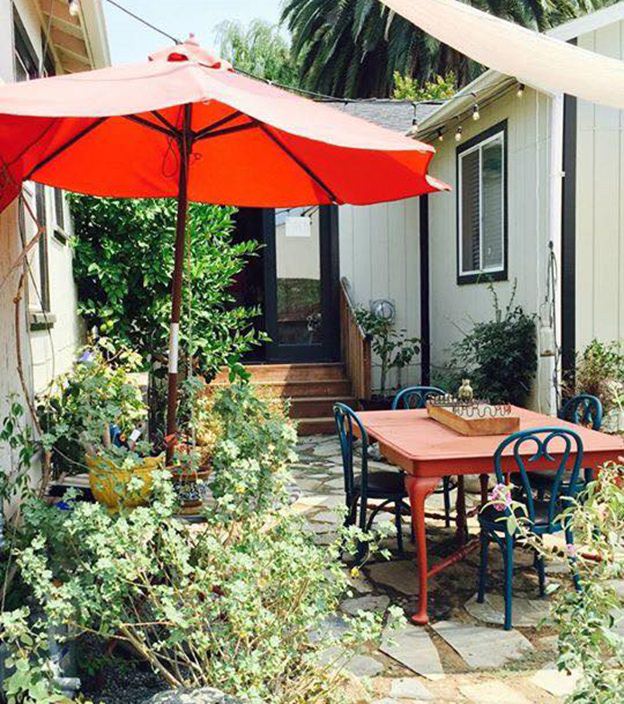
In recent years, there has been a shift toward small-space dwelling and simplified living. The popularity of the tiny-house movement has even earned it regulars spots on mainstream television. The economy has been a major unsolicited motivator for people embracing this lifestyle, but there are many more reasons people are choosing to live with less:
- environmental sustainability
- to escape hectic jobs
- to simplify their possessions
- to afford living in an area they love
- to free their funds up for experiences like travel
There isn’t a legal size definition for a tiny home, but in general, tiny homes considered to be 400 square feet or less, while small homes are between 400 and 1,000 square feet. Most of us aren’t going to shave enough of our earthly goods to squeeze into an 8-by-20-foot house on wheels, though downsizing your home and your possessions does pair nicely with sustainability and urban farming. Here are some reasons you might consider it.
1. Less House Equals More Land
A small house footprint leaves more room for land use. This is especially helpful in costly urban areas, where larger lots are at a premium, leaving many urbanites with a lot of house, very close neighbors and a sliver of yard. Older urban neighborhoods, built in the 40s or 50s are a great place to find smaller homes on larger lots—great for setting up an urban farm.
2. You’ll No Longer Feel House-Poor
A small, energy-efficient home translates into significantly lower cost of house maintenance. A tiny home is usually paid off by the time it’s built, meaning no monthly mortgage to pay. This can free up funds for cultivating your urban farm.
3. You Don’t Have to Live Tiny Alone
Several tiny homes can be placed on a communal property, so multiple people can contribute to one urban farm. If you happen to be lucky enough to know several people that share your dream of tiny-house and urban-farm living—people that you can stand to be around for long periods of time and that you could successfully share and manage land with—then this might be the plan for you.
4. Tiny Homes Can Be Temporary
Maybe you dream of building a more traditional farmhouse someday but don’t have the funds just yet. A tiny house can provide simple yet comfortable transitional shelter to live in while you work to get your farm running and build your permanent home. After you’ve accomplished your farmhouse vision, the tiny house can be set up as a guesthouse, in-law unit, or even a rental home to bring in extra income.
5. There’s Less House to Clean
Running a farm—even an urban farm—is time-consuming and dirty work. It’s also where most farmers want to be: outside. The last thing we’re interested in doing when we come in for the day is clean house, especially if that house is the size of a typical American home (2,600 square feet). Smaller homes require the keeping of less stuff, hence less to pick up. Leave your muck boots at the door, your apron on the hook, take a shower, and relax with your favorite book. Doesn’t that sound nice?
6. Tiny Homes Reduce Your Environmental Footprint
One of the most noteworthy benefits of tiny-house living is the possibility of living sustainably. The smaller the home, the smaller the environmental footprint. Building with recycled materials and installing solar panels, rainwater-harvesting tanks and greywater recycling systems are some of the steps you can take toward creating a home that exists in harmony with its environment.
7. Less Stuff Means More Living
Most industrialized nations promote a consumer-based lifestyle. We grow up believing that we need more clothes, a bigger house, better car, cooler gadgets. It’s easy to get caught up in it. In reality we find ourselves endlessly chasing the proverbial end of the rainbow. The more we chase, the less fulfilled we become, eventually convinced we will never have what we need to be happy.
Over the years, I have been shedding the excess in my own world and I am constantly amazed at how little I need to be comfortable, functional and happy. In fact, as I let go of the materialism and embrace the dirt in my hands, listen to the soothing clucks of my contented flock or witness the wonder of the new life in the garden, I find myself wanting and needing less. It truly is nature’s Xanax. And the sheer relief of having less to carry around, find places for, keep nice… it’s transforming. Life is so far and beyond the stuff we carry, but it’s hard to see that with all that clutter in the way.





